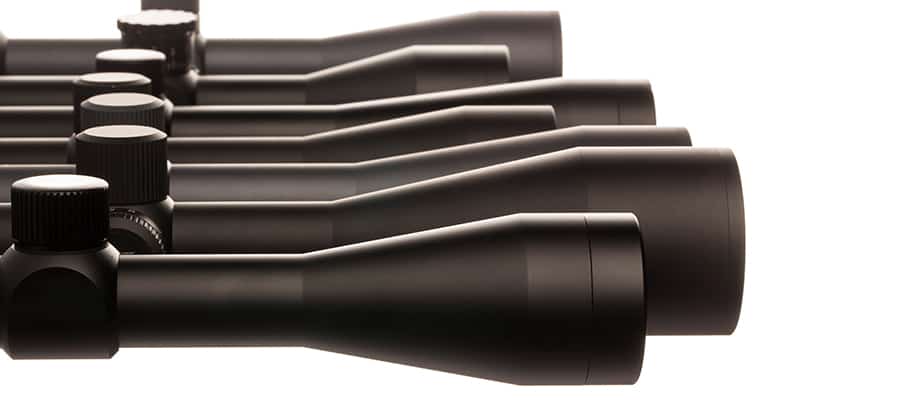 Choosing an air rifle scope can be tricky. With many different types of scopes and thousands of reviews available, how can you find the right one?
Choosing an air rifle scope can be tricky. With many different types of scopes and thousands of reviews available, how can you find the right one?
It’s no surprise that every airgun scope maker claims their air rifle scope is the best. But we’re here to cut all the marketing crap and help you find the perfect scope for you. Don’t waste your hard-earned cash on a sub-par scope that won’t get the results you want.
Why Do You Need An Air Rifle Scope?
Most of your stationary air rifle shooting targets will be at least a few meters away. A high-powered scope will help you aim at and hit the relatively small area of the target. Hunting targets (i.e., living, moving birds and animals) are even more difficult to hit from a distance. Using a scope while hunting will help focus and aim with accuracy. A good air gun scope will help you zero in on your target and get the highest possible degree of accuracy by giving you a clear, magnified view of your target.
Many air rifles come with scopes, but some are better than others. A good air rifle scope can make the difference between hitting bagging that game or trophy and coming home empty-handed. None of us want to be empty-handed, am I right? Many air gunners have the scope that came with their airgun replaced for this very reason.
Let’s be honest, airgun manufacturers are focused on making an awesome air rifle. Did we expect them to ship the best scope on the market too?
The Right Scope for the Air Rifle
Some air gunners try to use the scope from a firearm rifle on an air rifle. This is could be a bad idea.
Back in the day, as airgun power was being ramped up the forward recoil in airguns increased significantly. Scope manufacturers up to that point hadn’t had to deal with forward recoil.
In a springer when you pull the trigger, there is a recoil driving backward just like any rifle. What people failed to account for, is the second recoil. In a springer, the piston moves forward and stops when it impacts the end of the compression chamber. This impact drives a forward recoil.
Manufacturers, for the most part, have solved this problem. Their scopes are braced more appropriately now. You need to know this and keep an eye out when looking at scopes though. Invest your time appropriately to ensure your scope is designed correctly and won’t fail on you.
Don’t let people scare you away too much with their talk of air rifle scopes being different though. As long as you pay attention you’ll be fine.
Reading an Air Rifle Scope
When shopping for an airgun scope, you’ll notice details like “4×15” on the scope. What do the numbers “4×15” mean? You’ll need to learn is to read these details as they’re important to ensuring you have the right scope.
In our example, 4×15 pertains to the magnification capabilities and lens size of this particular airgun scope. The magnification, 4X, means that the objects are magnified to four times larger than normal when viewed through this scope.
The size of the lens, in this case, is 15mm and is noted by the numeral 15. The size of the lens determines the amount of light entering the lens and corresponds with the brightness of the images you’ll see in the scope. In short, a larger lens lets in more light and produces a brighter image.
It may seem that an airgun scope with higher magnification would be best, but this is not necessarily true. The higher the lens magnification, the narrower its scope of view. At higher magnification, such as 16X or higher, the field of vision will be very limited and may be too high for a beginning or casual air gunner.
Airgun Scope Power
Consider your primary uses for the airgun when deciding on the right magnification. A low-powered scope of 4X or 6X magnification is fine for closer shooting like backyard plinking and short to mid-range targets. Lower powered scopes also offer a wider field of view so you can see around the target and predict the direction they’ll take.
For you, small game hunters out there consider 4X or 6X. Most of your small game shooting won’t be from very long ranges. You’ll also want that wider field of view because the small game moves quick. This is a case where bigger isn’t necessarily better. You wouldn’t bring a drag car to a dirt track, right?
Long-distance hunting may require magnification of 9X to 12X. For shooting stationary targets at 120 yards or more, a 12X scope is better because you won’t need to see as much of the surrounding area.
Air Rifle Scopes Types
Let’s look at the various types of air rifle scopes to understand the options.
Fixed vs. Variable Air Rifle Scopes
Air gun scopes may be classified as fixed or variable according to their mode of operation.
Fixed Air Rifle Scope
Just as the name implies, a fixed air rifle scope provides a fixed magnification of the target. A fixed air rifle scope model is typically displayed as something like “4×32.” This indicates that the scope is fixed at 4x magnified and may not be adjusted.
Variable Air Rifle Scope
A variable type air rifle gives you the option to adjust the magnification of the scope within a given range. A typical variable air rifle scope magnification is displayed as a range, like “3-9×32.” The numbers 3-9 indicate that the magnification may be adjusted from 3x-9x, as needed.
How to Choose
It may seem that a variable airgun scope–because of its versatility–will be superior to a fixed air rifle scope, but it’s not that simple.
For beginners, a variable scope would add one more element to become familiar with. In addition to learning about recoil, noise, positioning, and more, the beginner would also need to learn how to properly adjust the scope. A fixed airgun scope may be a better choice for a beginner, as it can help improve accuracy without becoming overwhelming. A new airgun user would probably be shooting at shorter ranges and be satisfied with a lower magnification.
After learning the basics and becoming more familiar with airgunning, you may eventually need to switch to a variable air rifle scope. Variable airgun scopes can be quite useful in hunting moving targets as the scope can be adjusted as needed.
Reticles
Reticles, or “crosshairs,” are the patterns you see when looking through the airgun scope. They help your eye focus better and center your target in the scope. There are several types of reticles, but Duplex Crosshairs and Mil-dot scopes are the most common. When choosing your airgun scope, it’s important to consider the type of reticle that will serve you best.
Duplex Crosshair Scopes
Duplex crosshair scope designs are made up of two intersecting lines–one horizontal and the other vertical. The lines are slightly thicker at the edges of the scope and become thinner toward the center. The thickness of the outer lines helps you to focus on the target, even in low light and against busy backgrounds. The finer inner lines help you to center your target without covering it. Duplex crosshairs are a popular choice for hunting.
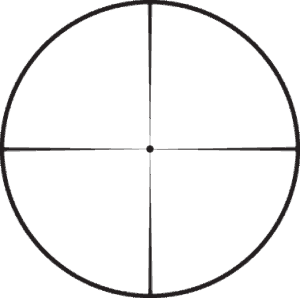
Mil-dot Scopes
Mil-dot scopes combine the intersecting lines of duplex crosshairs with additional dots used to improve long-range shooting. Due to an effect called “ballistic drop-off,” pellets fired from a distance will dip slightly due to gravity. Once an air gunner learns how to use the dots and crosshairs in the scope to calculate the pellet’s drop-off, they can adjust aim to greatly improve accuracy.

Why is this scope better for calculating with drop off? You can predict shots better with the different dots. Once you understand your ranges, and how your airgun performs you can adjust how the dots line up to your target for more consistent estimating. You can estimate with other scopes as well, but mil-dot scopes will provide the same result every time.
Many hunters prefer Mil-dot scopes for long-range game hunting.
Airgun Scopes for PCP and Spring-Powered Air Rifles
You may want a different scope for a PCP vs. a Springer airgun. While they may be interchangeable, the operates so differently a different setup is often preferred. Break Barrel and Spring Powered air rifles fire significantly differently. Their recoil is harsh, but the time the pellet takes to leave the barrel is slower. PCP and C02 airguns produce almost no recoil and can accommodate a lighter duty scope.
Airgun Scope Brands
There are several leading scope brands with mixed reviews. Some of the most popular brands are Leupold, Bushnell, Gamo, UTG, Hammers, and Hawke. I’m not covering every brand here, just giving you a brief overview.
Leupold
This Germon company has been around awhile. Leupold Air Rifle Scopes have been on the market since the early 20th Century and the brand currently offers several leading models.
Leupold VX-3i 4.5-14×50
The Leupold VX-3i 4.5-14×50 is a favorite among air gunners. Its duplex crosshair reticle maximizes brightness to provide the clarity you need. This scope is also very easy to dial in, and more importantly, it holds zero well. You won’t need to worry about missing a shot because you haven’t re-zeroed recently.
This model is more expensive than other airgun scope brands and air gunners on a budget may prefer a more affordable option.
One of the scopes touted features is the eye relief; however, opinions are mixed. The need to place the eye relatively close to the scope was a problem for some. This is a feature specific to the scope. The complaints are likely from people used to a different scope setup.
Depending on your budget and eye comfort, the Leupold V-3i 4.-14×50 may be the right choice.
Leupold Vx-Freedom 3-9×50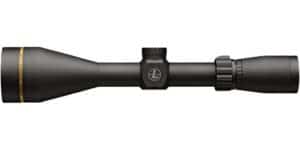
The Leupold Vx-Freedom 3-9×50 also features a duplex reticle and is more affordable than the Leupold VX-3i. Some users with less than 20/20 vision reported problems with the clarity of view in this model. If your eyesight is a potential concern, the Leupold Vx-Freedom 3-9×50 may not be the right option for you. Keep in mind those complaints were in the vast minority.
Bushnell
A well-known company, Bushnell specializes in manufacturing sports optic products, including binoculars and several highly rated rifle scopes.
Bushnell 4.5-18X40 AR Optic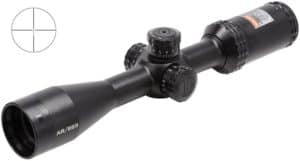
The Bushnell 4.5-18X40 AR Optic was made for long-range shooting and features a mil-dot reticle. Many users are satisfied with their accuracy, even at long-distance, while others complain that this scope is not effective with low drag ammunition. If you’re willing to experiment with different types of pellets, the Bushnell 4.5-18X40 could the right scope for you.
Gamo
Gamo produces rifles and airgun scopes at a lower price point than Leupold and Bushnell. If you are looking for practice airgun scopes under $100, Gamo airgun scopes might be for you. That said, later, we mention another inexpensive brand with a better reputation in scopes.
Gamo Air 4×32
One of the best selling scopes from Gamo is the Gamo Air 4×32. It has a duplex reticle, with many users praising its clarity and ease of use. However, some users complained that it’s too easy to adjust, even by accident. Others raise issues with durability and short life span. The Gamo Air 4×32 could be a good beginner scope or an inexpensive option for casual plinking and varmint control.
Gamo 3-9X40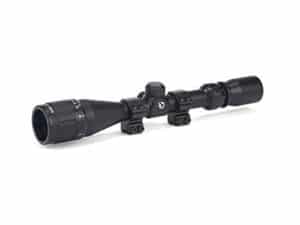
The Gamo 3-9X40 airgun scope is highly recommended for casual target shooting small to medium sized game hunting. Because it’s a variable scope, many users were satisfied with the Gamo 3-9X40 as a transition from using a fixed scope. The biggest complaint with this model was its potentially short life span.
A note on “potential” short lifespan. People tend to rate products that aren’t as weighty as cheaper. That’s a bit of a false correlation. So, it could be true, or it could be a WAG… Wild Ass Guess. Consider your price to durability ratio. You can’t compare an inexpensive scope to the Leupold above and expect them to have the same quality. It’s like comparing apples to oranges.
UTG
Under the Gun (UTG) offers a selection of affordable airgun scopes, with many priced below $100.
UTG 4×32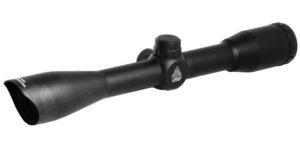
The UTG 4×32 is a favorite because its mil-dot reticle makes it ideal for both long-distance target shooting and small game hunting. Some users raised issues with its durability, particularly when used with Gamo and Benjamin model air rifles. The UTG 4×32 may deliver better results when paired with Hatsan airguns.
UTG 3-9X40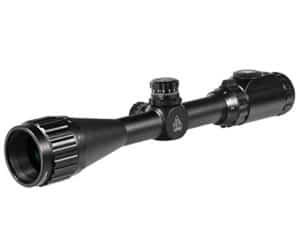
The UTG 3-9X40 is beloved for hunting and plinking because of its quality and clarity. The 3-9X40 is another UTG model that may not be compatible with high-powered air rifles. Some users also mentioned that the cap is inconvenient.
Hammers 3-9x32AO
The Hammers 3-9x32AO was specially made to withstand the recoil of high-powered springer airguns. This model’s price (below $90,) combined with its quality, has earned many loyal fans. Other users complain that it’s less reliable with specific high-power brands. The 3-9x32AO is perhaps best used with the Ruger Black Hawk and Crosman Air Rifle.
Hawke Airmax 3-9×40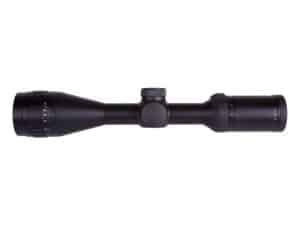
The Hawke Airmax 3-9×40 features a unique glass etched mil-dot reticle that makes it perfect for backyard plinking and target shooting. Air gunners praise the reticle and comment on its crisp, clear view of the target. Critics complain that this model’s price is too high and isn’t bright enough for hunting. The Hawke Airmax 3-9×40 may be best for target shooting.
CVLIFE Tactical 3-9X40 Optics R4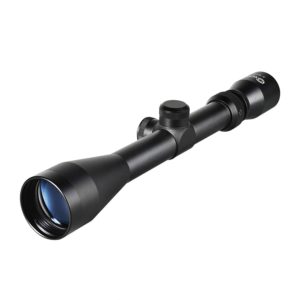
If you are looking for a really good deal check out CVLIFE scopes. They are inexpensive but perform very well.
When I bought my Gamo Swarm and didn’t feel like buying an expensive scope this is the option I went with, and I’m glad I did. The CVLIFE Tactical 3-9X40 Optics R4 zeros well, and holds it. It’s very clear and does exactly what I need it to do. Honestly, this scope just does more than you pay for. Is it as good as the most expensive options? No. Is that fine for those of us spending so little? Yes.
So, Now What?
You do so much research to make sure you get the right airgun you need to take the time to get the right accessories. Now you are armed with the knowledge you need to pick the right scope. We’ve mentioned some great options above, but they aren’t the only options. Heck, if you followed this link to a search for air rifle scopes on Amazon you’ll see a plethora of options, and tons of brands we didn’t have time to cover.
Use what we’ve told you to make your comparison and pull the trigger. Your airgun deserves the right scope.
This article is meant as an overview. The scopes we mention are meant to be examples of what you’ll find out on the market. If you think you’re ready to buy your best bet is to head over to our recommended gear page where we do more specific reviews.
